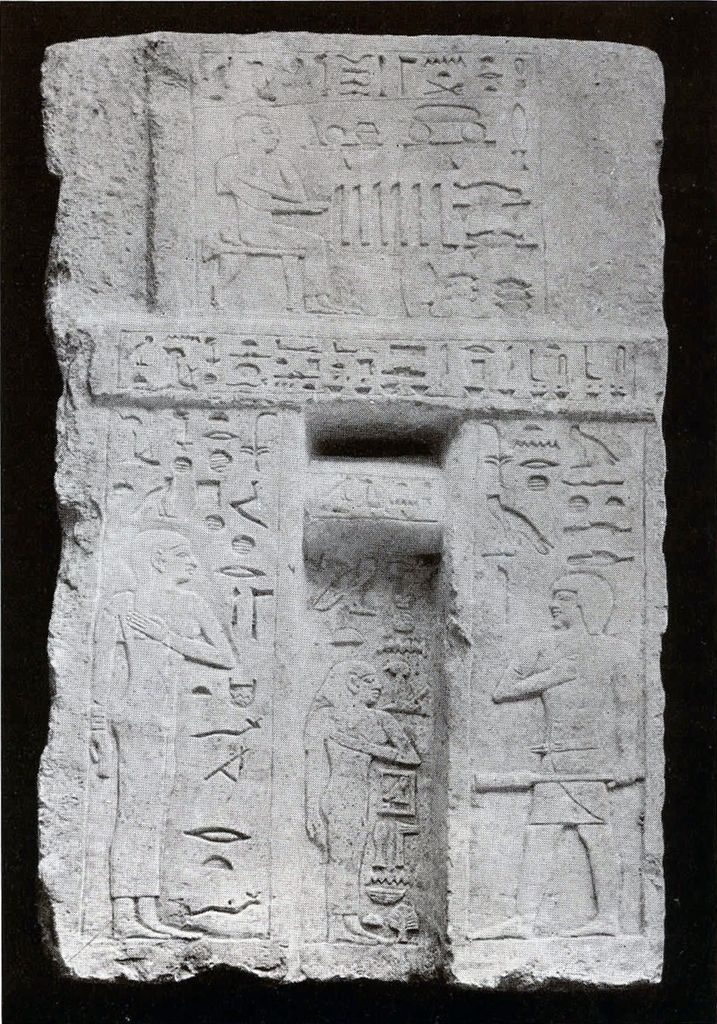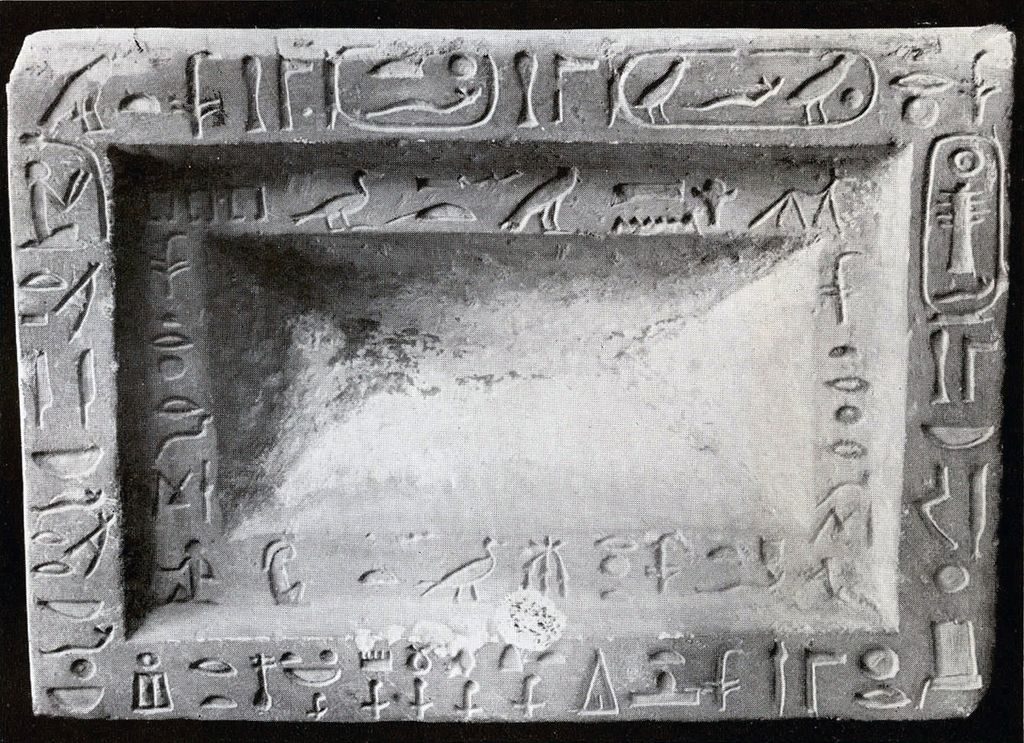The Eckley B. Coxe, Jr., Expedition to Egypt
The Royal Cemetery of Gizeh occupies many acres of the high plateau behind the Great Pyramid, and its clearance has been nearly completed by the various expeditions among which it has been divided.
That part of the cemetery excavated by the Eckley B. Coxe, Jr., Expedition of the University Museum was a part of that section previously assigned to the Harvard Boston Museum Expedition, lying along the extreme northwest edge and enclosed on the east, south and west by mastabas of the Cheops period. These were arranged in parallel rows and were obviously built on regular plots of ground assigned by the king to his chief officials. The area which we excavated contained tombs of priests and minor officials. The regularity of the more important cemetery was lacking and it was clear from the overlapping and rebuilding of many of the tombs that the area had been used over a long period.
The sepulchral portions of the tombs were the common type of the period. All the shafts were carried down to a depth of two to six meters into the rock, and it is interesting to note that this was done after part at least of the superstructure of the mastaba itself had been completed. At the bottom of each shaft was a small rock chamber, sometimes scarcely more than a recess. This usually opened from the west side, but in our cemetery this rule was adhered to only when the position of a shaft or chamber of a neighboring tomb did not interfere. In the older tombs which we cleared the burial itself was in a shallow pit sunk in the floor of the chamber. In this cavity was placed the body, sometimes enclosed in a plain wooden coffin, and the pit was then covered with rough slabs of stone. Many tombs had been disturbed by grave robbers, but even those which had remained intact contained, with a few exceptions, no pottery or other funerary objects. Nearly all the pottery found came from the debris either in the shafts or in the offering chambers.

One of the most important mastabas was found near the southeast corner of the area. It had a rubble core, with shafts and exterior walls faced with mud bricks. An offering chamber was built against the east façade, which contained a series of niches. Against the two southern niches had later been erected a limestone niche (false door) and a relief. The relief is a portrait of the owner, a certain Medady, who is described as “acquaintance of the king, companion of the commander of the army.” The niche stele was more interesting. In the upper panel (Fig. 15) is a low relief representing a woman seated in the usual manner before a table of offerings; above is her name and position, “Concubine of . . . (?), priestess of Wep-wat, Kha-khenmet.” Across the lintel is a list of offerings, including wine, figs, etc. Below on the pseudo-log lintel her name appears again, “Kha-khenmet.” In the niche itself the woman is standing, with the inscription, “Kha-khenmet, priestess of Hathor, the Mistress of the Sycamore (i.e., Hathor of the Pyramids).” In the left panel she appears again with the inscription, “Acquaintance of the king, revered before the great god, his (i.e., Medady’s) beloved wife Kha-khenmet.” In the right panel is Medady himself with practically the same inscription as that on his own portrait stele. The tomb therefore belonged to a minor official and his wife or concubine. These two teens are here used interchangeably, and we know from other inscriptions of the same character that this relationship was not uncommon and that the position of concubine, a sort of second wife, carried no stigma.

In a small space between the offering room of the Medady mastaba and one of the large Cheops mastabas east of it, a beautiful little statuette was found (Fig. 16). This portrait statuette is perfectly preserved and still has the coloring in fresh condition. The skin is painted red, the wig and eyes black; the skirt and collar have lost part of their original yellow color. On the base is inscribed, “Overseer of boats (?), Mesty.”
Near the north end of the cemetery were two small mastabas belonging to a priest Ruwz and his relatives. The two tombs did not adjoin one another. That of Ruwz and his wife was built against the north side of a fine stone cased mastaba, while that of his father and mother lay to the southwest, separated by a space from that of Ruwz himself. Both tombs were of mud brick construction throughout, and that of the parents had the offering chamber arched with mud bricks on which reeded decoration was worked in mud plaster. In the rooms were three niches and on the floor were three offering basins of limestone. The first bore the following inscription around its rim: “May the king and Anubis, first in the temple, give an offering. May there be buried in the westland in a great old age the lord revered before the great god, the purifying priest of the king’s mother, the judge over the bank, the judge of the ‘son of the house’ (meaning unknown), the revered before his mistress, Ruwz.” This is a libation basin which Ruwz placed in the tomb of his parents. The second basin is inscribed: “May the king and Anubis give an offering. May there be buried in the western desert in a good old age (‘the revered’ omitted) before the great god, the acquaintance of the king, Per-senet. This was made for the mistress of reverence before the (great) god by the son of her body, the purifying priest, Ruwz.” This slab therefore was dedicated by Ruwz for his mother. The third basin is that of the father: “May Anubis, the foremost in the underworld, give an offering (for) him who is buried (in) the western desert, the lord of reverence, the gate porter, Iy-mery.” Near one wall of the chamber stood a large pottery stand inscribed: “Overseer of purifying priests, Iy-mery.”

Museum Object Number: E13514
Image Number: 31093
Turning now to the tomb of Ruwz and his wife we have first in an anteroom at the northern end of the offering chamber a small red granite slab with the inscription: “Purifying priest of the king’s mother, Ruwz; his wife Mesat; (funerary offerings) houses, loaves, beer, cakes, fowl, cattle.” Behind this in a small space roofed with stone slabs was a fine limestone offering basin inscribed: “His beloved wife Mesat, the acquaintance of the king, Mesat; libation priest of the king’s mother, Ruwz; judge over the bank, Ruwz.” The latter title is known to be an official title from other inscriptions, but its meaning is obscure, possibly it refers to duties connected with irrigation, ferrying or shipping. In the main chamber before the central niche was the important offering table of Ruwz and his wife (Fig. 17). This had a long inscription covering all four sides of its double ledged rim. It runs: “Acquaintance of the king, priest of Cheops, priest of Chephren, purifying priest of the king’s mother, beloved of his lord (i. e., the king), whom his lord loves every day, priest of Dedefra, revered before the great god. May the king give an offering, a thousand loaves of bread, a thousand jugs of beer, a thousand pieces of linen, a thousand garments, a thousand of all good things daily (for) the judge over the bank (canal ?), the companion of the son of the houses, the acquaintance of the king, Ruwz, (and for) his wife, the acquaintance of the king, Mesat.”
The importance of this inscription lies in the fact that it contains the cartouches of three kings of the fourth dynasty, Cheops, Chephren and Dedefra. The latter is usually placed between Cheops and Chephren, but the order here would seem to indicate that he really followed Chephren. Only four other examples of this cartouche are as yet known. The position of purifying or libation priest to the Queen mother was an important one, corresponding to a father confessor. In addition to the obscure title of ” judge over the bank ” which occurred in his other inscription, we have here another one, “the companion of the son of the houses.” This also is a known title of which the meaning is obscure. This group of inscriptions is of considerable interest. It is quite evident that both mastabas and libation basins were the gift of Ruwz. We see that he had a very humble origin as his father was only a gate keeper who married a woman who had some influence with the king. Through this, it would appear, her son Ruwz prospered until he finally obtained the important post of libation priest to the king’s mother. He also married a court lady, and with his accumulated means built for his parents as well as for himself and his wife their final resting places. If the inscription on the jar stand found in Iy-mery’s tomb refers to the father of Ruwz, it would appear that Ruwz also used his influence to raise his father from a gate-keeper to an overseer of the libation priests.
An interesting stele came from a small mud brick mastaba in the middle of the area. It belonged to Khufu-mer-neteru, “commander of ten (ships?).” Another stele broken in several pieces came from the extreme western limit of our cemetery. It belonged to the funerary priest Ankh, and was dedicated to himself, his concubine Ked-nofret and his two daughters Khent-ka and Ked-nofret.

Image Number: 33786
In the space between the two Ruwz mastabas was a rough stele and offering basin belonging to a woman. After the usual formula the inscription on the stele ends, “. . the acquaintance of the king, Nofer-hotep-es-wer. The son of the king, of his body, Duwa-ra. His daughter, the acquaintance of the king, Nofer-hotep-es.” The two names here are the same, but in one case the hieroglyph “wer” (i.e., “the elder”) is added, probably to distinguish her from a daughter or sister of the same name. She is called the daughter of Duwa-ra, who is a prince of the royal house. This Duwa-ra may be the same as the prince Duwa-ra of the mastaba found by Dr. Reisner in the main cemetery.
At the northern end of the area was a large mud brick mastaba with the exterior walls and the offering chamber faced with dressed masonry. Most of the exterior facing had been removed later, but the offering chamber remained practically in its entirety. It was lined with limestone covered with stucco, on which were drawn in red numerous offering scenes. The tomb belonged to Sneferu-hotep and his wife Khennût-nist-em-yenty. Sneferu-hotep is not given any title except the usual “acquaintance of the king,” but his wife was a priestess of Hathor, of Neith and of Wep-wat.
Other minor tombs were those of Nofer, chief of the silver treasury, and Nofret, wife (?) of Thenty. Near the western side was the mastaba of the funerary priest Sobef. The roof of the offering chamber was vaulted with mud bricks designed so as to interlock. These are, so far as I am aware, the only examples of interlocking bricks yet found in Egypt, and the oldest examples of such technical skill.
C.S.F.

